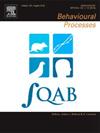行为证据表明,自由运动模式y迷宫中的重复反应与衰老相关的工作记忆缺陷有关。
IF 1.3
4区 生物学
Q4 BEHAVIORAL SCIENCES
引用次数: 0
摘要
视觉空间工作记忆(VSWM)对于导航复杂的环境至关重要,并且随着年龄的增长而下降。在动物研究中使用的自由运动模式(FMP) y型迷宫,通过分析左(L)和右(R)反应重复交替序列(LRLR等)的个体差异,为评估VSWM提供了一个强大的范式,这是许多物种的主要搜索模式。先前的人类研究使用了蜂窝状的迷宫,设计用于连续搜索和基于轨迹的导航,并显示出与年龄相关的交替反应性能下降。到目前为止,还没有研究在封闭的y形迷宫中人类的反应,忠实地复制动物实验的离散手臂进入条件。实验1重复了蜂窝y型迷宫的实验结果:年轻参与者(18-40岁)表现出较高水平的交替旋转(LRLR/RLRL),而年龄较大的参与者(70岁以上)则表现出明显的顺序重复反应(LLLL/RRRR)。实验2表明,变化反映了VSWM。具体来说,在数字Corsi测试(一种有效的VSWM测量方法)中,交替反应的比例与更高的分数之间存在显著的相关性。当交替反应在实验3中得到加强时,年长的参与者仍然比年轻的参与者交替反应更少,重复次数更多。这些发现表明,与年龄相关的VSWM下降支持了在老年人中观察到的重复搜索模式。通过忠实地复制动物研究的条件,封闭的FMP y迷宫为评估人类VSWM提供了一个简单、可扩展的工具。它的设计特别适合游戏化、增强动力、减轻压力和个性化干预,以提高老年人的表现。本文章由计算机程序翻译,如有差异,请以英文原文为准。
Behavioral evidence that repetitive responses in a free-movement pattern Y-maze are associated with ageing-related deficit in working memory
Visuospatial working memory (VSWM) is crucial for navigating complex environments and is known to decline with ageing. The Free-Movement Pattern (FMP) Y-maze, used in animal studies, provides a robust paradigm for assessing VSWM via analyses of individual differences in repeated alternating sequences of left (L) and right (R) responses (LRLR, etc.), the predominant search pattern in many species. Previous human studies have used a honeycomb-shaped maze, designed for continuous search and trajectory-based navigation, and have shown ageing-related decline in performance of alternating responses. To date, there has been no examination of responses in the closed Y-maze in humans, faithfully replicating the discrete arm entry conditions of animal experiments. Experiment 1 replicated results observed in the honeycomb Y-maze: younger participants (18–40 years) displayed higher levels of alternating turns (LRLR/RLRL), while older participants (70 + years) exhibited predominantly sequential repetitive responses (i.e. LLLL/RRRR). Experiment 2 demonstrated that alternations reflect VSWM. Specifically, there was a significant correlation between proportion of alternating responses and higher scores on the digital Corsi test, a validated measure of VSWM. When alternating responses were reinforced in Experiment 3, older participants still alternated less and repeated more than younger participants. These findings suggest that age-related declines in VSWM underpin the repetitive search patterns observed in older adults. By faithfully replicating the conditions of animal studies, the closed FMP Y-maze offers a simple, scalable tool for assessing VSWM in humans. Its design is particularly suited for gamification, enhancing motivation, reducing stress, and personalizing interventions to improve performance in older populations.
求助全文
通过发布文献求助,成功后即可免费获取论文全文。
去求助
来源期刊

Behavioural Processes
生物-动物学
CiteScore
2.70
自引率
7.70%
发文量
144
审稿时长
4-8 weeks
期刊介绍:
Behavioural Processes is dedicated to the publication of high-quality original research on animal behaviour from any theoretical perspective. It welcomes contributions that consider animal behaviour from behavioural analytic, cognitive, ethological, ecological and evolutionary points of view. This list is not intended to be exhaustive, and papers that integrate theory and methodology across disciplines are particularly welcome.
 求助内容:
求助内容: 应助结果提醒方式:
应助结果提醒方式:


